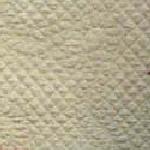America's Quilting History
Whole-Cloth Quilts: Subtle Beauty in Texture
One of the first quilting styles brought to America by immigrants was that of the subtly elegant whole-cloth quilt. The beauty of these solid white or colored quilts comes from elaborate, closely quilted designs that bring texture and shadows to the piece. Quilting these intricate quilts required highly skilled needlework. For the most part only those women of wealth and leisure had the time to develop and use these skills. The designs on these quilts were often floral combined with feathered and geometric patterns. Some even included figures of ships, animals and people.

Many whole-cloth quilts were made with glazed wool and wool batting. They were often in bold colors, particularly the colorfast indigo and red. These quilts were the successor of the woolen petticoats that 18th century women wore. Dresses were designed with an open panel to show the lovely quilting beneath. Later some of these petticoats were made into quilts * by cutting the length in half and sewing the two resulting panels together. Thus it is sometimes confusing as to whether a book or record is referring to a piece of clothing or a quilt when the word "petticoat" is used.
The more formal of these whole-cloth quilts were made with white cotton while white linen was often used for the backing. Usually these quilts had a central design with repeated florals and or geometrics surrounding it.
A skilled quilter often took an even more difficult step. She would stuff some of the motifs with additional batting to give a greater sense of depth. After the quilting was completed a small pointed instrument called a bodkin was used to separate the threads of the backing. Through this tiny opening the quilter painstakingly stuffed small bits of additional filling. The finest of needleworkers were able to make the back almost indistinguishable from the top! This technique is called stuffed work or Trapunto. These masterpieces were sometimes finished with a cotton fringe.

The art of making these fine quilts was first popularized in France and soon became highly favored in England as well. Because these quilts were in such demand eventually French weavers developed a way to make these beautiful textured quilts on a loom. The bedcoverings they wove came to be called Marseilles quilts. As I sit here writing this article I notice that my bedspread is a distant woven relative of the Marseilles quilt. When I consider that the method of quilting beautiful designs on solid fabric originated in Sicily in the 14th century I realize that my seemingly ordinary bedspread comes from a tradition that has evolved over 6 centuries.
It is less well known that there was a more recent renewal of interest in whole cloth quilts with their elegant quilting. Fawn Valentine reports, "Whole-cloth quilts made of cotton sateen were popular in the first half of the twentieth century ..." 1 The Arts and Crafts Movement had encouraged people to go back to a simpler way of decorating their homes after the extravagance of the Victorian Era. The introduction of the sewing machine also had its part in inspiring women to made whole cloth quilts. The book, Hearts and Hands tell us, "All-white quilts, avoiding the distractions of fabric pattern and color and of pieced designs, were especially favored as showing the possibilities of machine quilting as well as the makers prowess at complex embellishment." 2
An indication that women wanted this whole cloth look can be found in Ruth Finley's book published in 1929. In it she bemoaned the following practice saying," Thus it happened that, when colored counterpanes began to go out of style in the late seventies, many a woman turned her gay red and green masterpiece wrong side up, thereby dressing her bed without added expense in fashionable plain white."2
© 2001 (updated 2003) Anne Johnson(Do not reproduce any material from this site without permission.)
References:
1 p8 "West Virginia Quilts and Quiltmakers: Echoes From the Hills", by Fawn Valentine
2 p39 "Hearts and Hands: The Influence of Women & Quilts on American Society", by Pat Ferrero
3 p138 " Old Patchwork Quilts and the Women Who Made Them", by Ruth Finley
"Old Sturbridge Village" at "Northern Comfort: New England's Early Quilts"
"Clues in the Calico", by Barbara Brackman
"Quiltmaking in America: Beyond the Myths", Laurel Horton (Editor)


